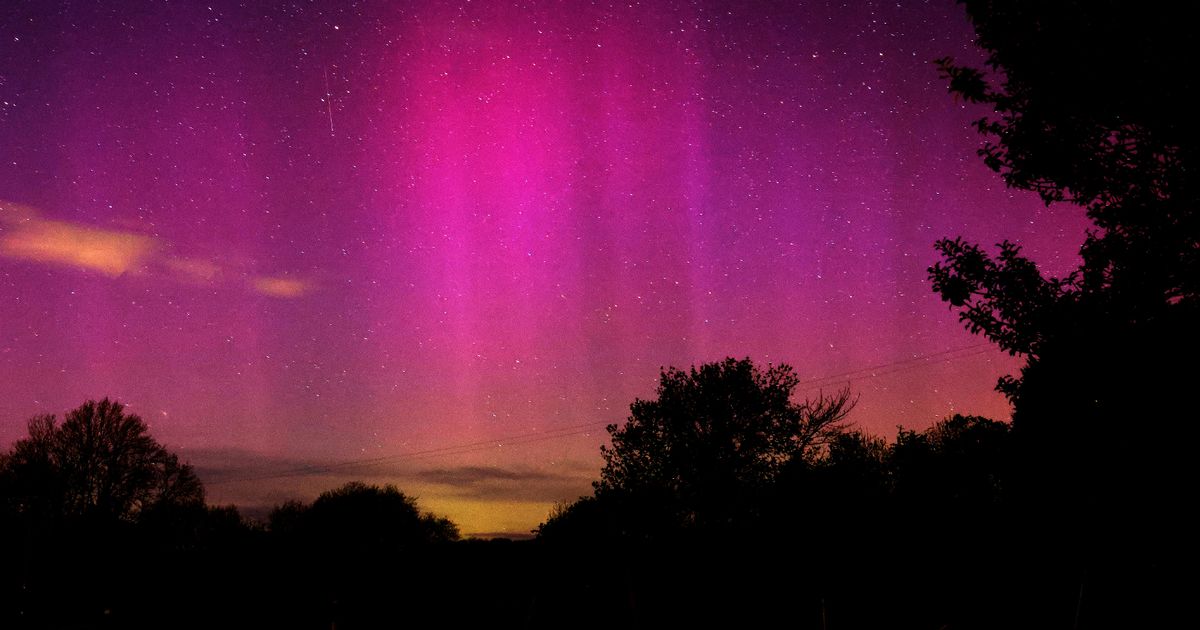The aurora borealis is expected to be visible from the UK following a coronal mass ejection from the sun that’s set to hit our atmosphere The Northern Lights visible from Monmouthshire in east Wales in April this year(Image: John Myers)
The Northern Lights visible from Monmouthshire in east Wales in April this year(Image: John Myers)
Residents in Wales and throughout the UK may witness the Northern Lights on Friday night, according to the Met Office. The aurora borealis is anticipated to be visible following a coronal mass ejection from the sun, which is expected to reach our atmosphere shortly.
The Aurorawatch UK project has issued a ‘red alert’ on Friday (November 7), indicating that with reasonably clear skies people may be able to stare up into the sky and see the Northern Lights without any equipment.
The Met Office Space Weather forecasting service stated: “The auroral oval is likely to become enhanced over the coming days, due to glancing CME (coronal mass ejection) effects and then a coronal hole fast wind. Aurora is increasingly likely to become visible from Scotland and similar geomagnetic latitudes by November 7.
“There is then a chance of aurora being seen from Northern Ireland and northern England, and a slight chance of glimpses from Wales and central England, although confidence here is low.”
A coronal mass ejection occurs when a massive cloud of charged and highly magnetised plasma bursts from the solar corona into space, triggering radio and magnetic disruptions on Earth.
The Northern Lights, also known as aurora borealis, are usually only visible from northern latitudes. Nevertheless, during a coronal mass ejection (CME) – a solar eruption of charged particles – the aurora can reach more southern latitudes, including the UK.
The Met Office has suggested that the aurora borealis could be visible as far south as Lancashire, the Midlands, and Wales, assuming conditions are dark and clear.
Content cannot be displayed without consent
The Met Office said: “Solar activity has been Moderate over the past 24 hours with two moderate class flares. Both have been from the complex region in the northeast.
“There are six active regions visible on the solar disc, with the complex region in the northeast remaining the largest and most notable and shows significant magnetic complexity.
“Several CMEs (Coronal mass ejections) were seen leaving the Sun during the 24-hour period. A CME associated with the M7.6 flare at 05/1118 UTC from AR4274 may give a glancing blow with Earth on the 07th of November.
“A further CME associated with the M8.6 flare from AR4274 at 05/2207 UTC is currently undergoing analysis.”
The stunning celestial display happens when the sun enters a particularly active phase, releasing vast quantities of charged particles – known as solar wind – into space.
These particles get trapped by Earth’s magnetic field and collide with gas molecules in the upper atmosphere, sparking a geomagnetic storm.
The powerful collisions emit light across various wavelengths, creating the mesmerising multicoloured display recognised as the Northern Lights. Britain is currently witnessing an increase in aurora sightings, driven by the Sun’s solar cycle.
The Royal Astronomical Society (RAS) has announced that we are nearing the apex of the 11-year solar cycle, referred to as the ‘solar maximum’.
The RAS states that during this period, sunspots, flares, and Coronal Mass Ejections (CMEs) all become more common.
This surge in geomagnetic activity enhances the likelihood of witnessing the aurora borealis at lower latitudes, including right here in the UK.

